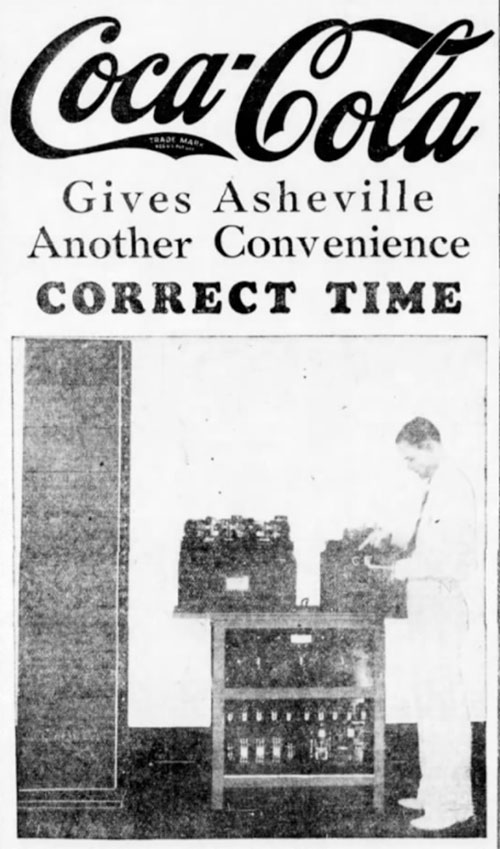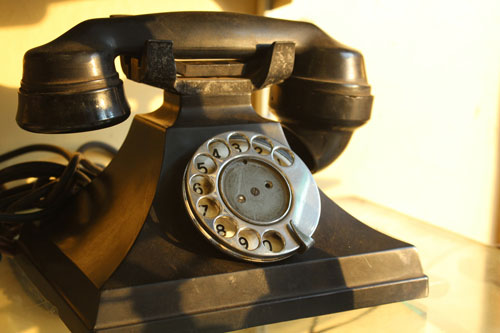More Dialing, More Weirdness
There are lots more weird phone numbers out there—and some of them have pretty fascinating stories. Read on to learn more about the vintage phone system.
P.S.:A quick shout-out tonight to Patreon supporter Brian Christie of the knowledge-sharing tech firm Brainsy. Here’s what his company is working on these days. Thanks for the support!
Are you in NYC, San Francisco, Chicago, Los Angeles or Washington DC? We do unconventional tours at the best museums in your city. It’s kind of like the tedium for museums. We don’t talk about the most famous paintings or the newest collection, we find the esoteric stories that make even the “boring art” amazing.
“I read an announcement and the engineer said, ‘That’s great, but you’re three-tenths of a second off.’ I knew what to do with two or three seconds, but he was talking in tenths. Timing is absolutely crucial.”
— Jane Barbe, one of the most well-known voices in telephone history, discussing her 1963 audition with Audichron, the firm behind the talking clocks that were long in use for phone systems around the world. Barbe got the gig, and soon became incredibly well known for her dulcet tones, which told you what the time was, or told you that you had dialed the wrong number. Barbe, who died in 2003, was most associated with the Bell telephone system, while a colleague of hers, the slightly-more-nasally-voiced Pat Fleet—who is more closely associated with AT&T—has continued to carry the torch of telephone voice actors.
The forgotten advertising roots of Audichron, the company that specialized in “talking clocks”
The great gift that Audichron brought to the American public was a phone number that could help you set your clocks. This was not always an easy task, of course. There was a period in which setting a clock required a whole lot of guesswork.
And in the pre-automation days, the telephone operator was the one stuck answering the question. This was frustrating, and telephone companies struggled with this task. In one notable example, Vermont’s Middlebury Register featured a 1918 announcement ad from the New England Telephone and Telegraph Company emphasizing that telephone operators would no longer accept calls simply asking for the time of day.
“For such information 100,000 calls are made daily in New England, the bulk of such calls coming naturally at times when it is most difficult to handle them,” general manager W.R. Driver wrote.
Ernest Esclangon, the director of the Paris Observatory in the 1920s and 1930s, faced a similar problem. Because of what the observatory did, it tended to have a very accurate time, one that was the standard-bearer for the entire country. As a result, people would constantly call it up, asking what time it currently was. This would constantly jam the single telephone line at the observatory, talking away from the actual goal of the observatory: Astronomical research.
But Esclangon had a better solution to the problem than Driver. Rather than discourage the calls, he automated the answers, coming up with a system that accurately described the time based on when people would call.
“Controlled by one of the master clocks of the Paris observatory, the talking clock always speaks with authority,” Popular Mechanics reported in 1932.
This proved an immensely useful service for the public, and when it finally was launched for public consumption in 1933, the service successfully accepted 20,000 calls on its first day—despite the fact that 140,000 people called. People really wanted to know what time it was.
And it was only a matter of time, of course, before the United States received a service with a similar intent. And that service was run by Audichron, a company launched by a Georgia man named John Franklin.
Franklin, however, had an entrepreneurial spirit to him—he was competing with Coca-Cola at the time. It just turned out that his drink was called “Tick Tock Ginger Ale,” making it a good fit with anything time-related. Before the early ’30s, this mostly meant advertising near large outdoor clocks.

If you can’t beat ’em, sell ’em ad space. (Asheville Citizen-Times)
But Audichron was a different beast entirely. And the success with the model ensured he would quickly leave the ginger ale behind. As author Sonny Kleinfeld explained in his 1981 book The Biggest Company on Earth : A Profile of AT&T, Franklin shrewdly used his machines for telling time as advertising fodder for all kinds of companies—including a former rival:
Initially, Franklin rented his time machines to local businesses. They would order additional phone lines from the phone company, hook up the time machines to them, and then devise promotional campaigns tied to the Time of Day. One of Franklin’s first clients was the Coca-Cola Company. The machines were an immediate hit, and Franklin had no trouble wooing an avalanche of customers. People called in swarms. It seemed that nobody knew what time it was. Seeing all this action, the phone company shrewdly mentioned to Franklin that, by the way, it would be very happy to buy his machines and install them in its central offices.
Nope, nope, nope, Franklin said. He wasn’t about to sell any of his time machines. He knew they were gold mines.
Those gold mines eventually led straight through to Jane Barbe, Pat Fleet, and numerous other voice actors that defined the modern telephone era.
By the 1970s, the company had expanded its reach by offering numerous services in a dial-up format, from weather to stocks. But the buzz wouldn’t last.

Five unusual phone numbers that you probably haven’t called before
Editor’s note: As I said in the last article, please don’t be idiots with these numbers … and keep in mind that numbers sometimes stop working.
- (909) 390-0003: If you dial this number and say hello, the phone will say hello back. This number is designed as an “echo number,” and is a good way to test the clarity of your VOIP calls.
- (202) 965-9970: “You have just deactivated this feature.” What feature have you deactivated? Beats me.
- (718) 238-9901: This is a standard verification code number, commonly used in the phone industry, but this Brooklyn-based number comes with an interesting twist—the guy in the message is talking in an Elvis voice. Thankyouverymuch.
- (509) 248-0036: “Your call has been completed. However, the party you are calling is not receiving calls at this time.” This would be the world’s most diplomatic voicemail intro to have after you’ve broken up with someone.
- (212) 255-9901: “Thank you for calling Amalgamated Bank. Due to Year 2000 testing and system maintenance, the system will be unavailable from 5 p.m. to 9 p.m.” Should I tell them, or do you want to?

A recently shared test page on Fax Toy. As of press time, half the images are criticizing CNN.
The website that quietly brings goofy faxes to the web
You have to wonder if the website FaxToy.net—a rudimentary online outpost that effectively displays anything that’s faxed to the numbers 1-855-330-1239 or 1-213-294-2943—should be a barren wasteland, an unused part of the internet that reflects an earlier era. It’s reminiscent of some of the earliest attempts at of internet memedom, having much in common with Hampster Dance or one of Jonah Peretti’s early onlineexperiments. Since the content is user-generated, it also feels a bit like PostSecret.
It doesn’t look like the kind of website people should be thinking about at all. (It rarely gets social media shares of any kind.) But when I loaded up FaxToy.net this morning, something surprising hit me in the face: A meme about a news story that happened literally today.
So how the heck did this happen? Turns out that this is the project of a guy named Kevin Savetz, a guy who has been interested in the concept of combining the internet with faxing since 1993.
“My thing with faxes started in 1993 or on Usenet,” Savetz explained in an email. “I maintained the alt.internet.services FAQ list. A few people asked how to send faxes from e-mail, so I had a Q&A about that in the document. Eventually I pulled that out into its own FAQ file called ‘FAQ: How can I send a fax from the Internet?’”
From there, it created something of an interest in the topic. Despite faxes quickly becoming usurped by the internet in general, Savetz found new ways to embrace them. At the tail end of 2005, he launched the little site FaxToy.net, with the goal of turning faxes into something of a two-way medium online.
“There was at one point a zillion years ago a tool that let you receive web pages via fax—you enter the URL on the keypad, like yahoo.com would be 82466266 and your fax machine would ring and send you a picture of that web page,” he explained. “But I wasn’t aware of a way to do the opposite—send faxes to a web page.”
So he created it—registering the domain on December 12, 2005, and soon coding the tool. At the time, the site did get some initial notice in the form of a blog post by noted geek Chris Pirillo. But these days, it lingers, mostly unwatched by the internet at large. I can only find a small number of people that have ever tweeted about it.
So why keep it going? As it turns out, Savetz has a business reason for leaving FaxToy alive! His company, Savetz Publishing, makes printable forms and business resources, and he also runs a service called FaxZero, which allows you to send faxes through the internet—for free with FaxZero branding, for pay without. So technically, you can send a FaxZero fax to FaxToy. (And plenty likely have! FaxZero has sent more than 15 million faxes since 2006.)

Savetz says he’s a big fan of the hand-drawn faxes.
The site, at this point, lives with limited human moderation—some things aren’t allowed, generally, but mostly it’s a bit of a free-for-all. (Savetz estimates that on an average day, it gets between 90 and 100 faxes.) And it does have some usefulness, as a way to confirm your fax machine is working properly. A number of faxes tend to be tests. But strangely, Savetz notes, the site has a quietly anonymous fan base.
“Occasional and one-time users who google ‘how to test my fax machine’ find it, test their machine a few times, then move on,” he explained. “But there seems to be a regular community—people who send a fax every day, or a few times a week, for months or years. The site pretty much runs itself, and I’ll sometimes check on it after weeks of ignoring it to find all sorts of goofiness going on.”
Maybe a few more people might fax, now that they know FaxToy exists.
We once asked a whole lot of the telephone system. This was a system that was required to help us acquire and distribute limited amounts of information through incredibly primitive means—and, for much of that time, to do it all with a friendly voice.
In many ways, Jane Barbe and Pat Fleet, among others, were the one modest layer of humanity we got when trying to convince a dumb machine to interact with us.
Eventually, we figured out new ways to make information more approachable. We eventually figured out how to bring the machines into our homes, without the extra layer of abstraction we previously used.
And that meant we generally no longer needed a “time number,” a tool that disappeared at the municipal level about a decade ago. Barbe and Fleet’s voices still sound familiar—there will always be error messages—but they probably won’t be at the peak of their pop-culture appreciation like they once were. (Worth noting: While Barbe, whose voice was heard more than 40 million times a day, died more than a decade ago. Fleet is still with us.)
But while we largely lost the talking time clock as well as its advertising-driven reason to exist, at least one number sticks around. The Atlantic notes that the U.S. Naval Observatory still draws in as many as 3 million calls per year, from people around the country, simply interested in the time. For what it loses as a municipal resource, it gains as an authoritative resource.
The voice on the end of that number—(202) 762-1401—is male, but professional and pleasant. (He has a name, too. It’s Fred Covington.)
In 30 years, we’re going to wonder about the voices of our AI assistants the way we currently do about the anonymous voices that define our modern phone system.
Maybe they’ll tell us the time, but that, for better or for worse, will only be the starting point.
:format(jpeg)/2017/06/tedium062717.gif)
/2017/06/tedium062717.gif)


/uploads/ernie_crop.jpg)